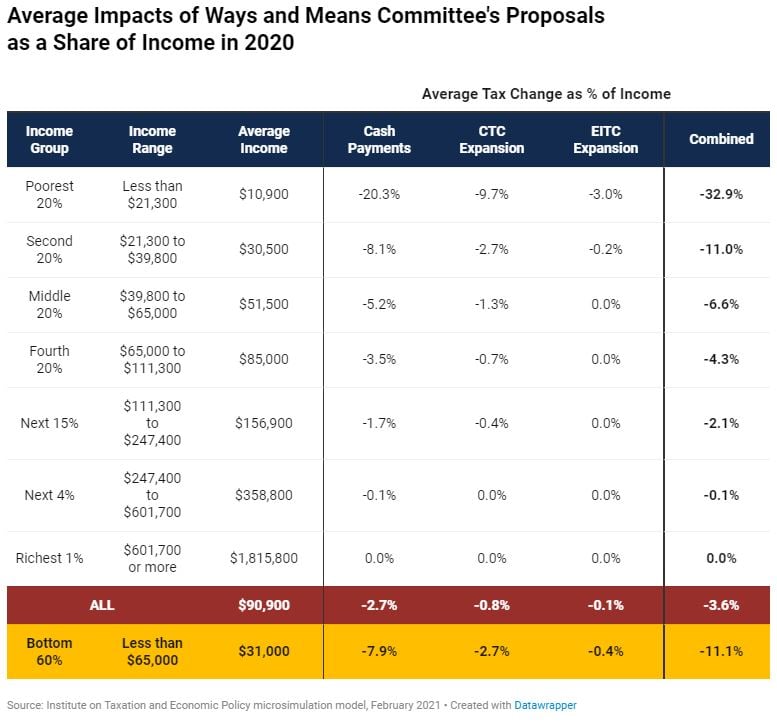While the federal EITC provides a great deal of support for families with children, its impact is limited for those without children or who are not raising children in their homes. Childless workers under 25 and over 64 have for far too long received no benefit from the federal credit. And workers aged 25 to 64 have received very little value from the existing credit (the maximum credit is much smaller and the income limits more restrictive). The federal EITC’s meager benefits for just some childless adults lead to an inequitable outcome: the federal income tax system—which is ostensibly based on ability-to-pay—taxes some impoverished, childless adults deeper into poverty.
Fortunately, Congress is weighing major improvements to the federal Earned Income Tax Credit. State lawmakers, too, can take both immediate and longer-term steps to strengthen and improve their state EITCs.
Enhancements Under the House’s COVID Plan Are Promising, Provide Vital Increase for Young Adults and Childless Workers
The House Ways and Means Committee’s COVID relief package, much like President Biden’s American Rescue Plan, would increase the Earned Income Tax Credit (EITC) for working individuals who are either childless or whose children do not live with them. In 2021, the maximum credit for these individuals is $543. The House proposal would nearly triple that amount and expand the phaseout range and income limit at which the credit begins to phase out. The proposal would also lower the age eligibility for the childless EITC from 25 to 19 and eliminate the upper age eligibility limit that currently bars people 65 and older from receiving the credit.
In total, the EITC components of the American Rescue Plan would provide around $13 billion in additional EITC benefits to childless workers. My colleague analyzed the effect of the EITC expansion at the national level and by state. Of those childless workers in the bottom 20 percent benefitting from the change, they would see an average boost of $740. The downloadable data are available here.
State Lawmakers Continue to Lead the Way
A handful of states, including the District of Columbia, California, Minnesota, Maine, Maryland, and New Jersey, have already enhanced their EITC for childless adults.
Innovative approaches at the state-level continue to make headlines, while lawmakers and advocates seek ways to improve economic security for their lowest-income residents. For instance, Gov. Larry Hogan of Maryland and Gov. Gavin Newsom of California have both proposed sending their state EITC recipients an additional cash payment. In California, the income-boosting payment would also extend to filers with Individual Taxpayer Identification Numbers (ITINs) who were largely left out of the 2020 federal stimulus relief, and who are too often left out of key policies that aim to mitigate poverty. In Oregon, a workgroup convened by Gov. Kate Brown released a report with five recommended reforms to the state’s EITC. The recommendations include age enhancements and extending the credit to ITIN filers.
In Washington State, lawmakers have proposed improving, and finally funding, the state’s Working Families Tax Credit (their state-level EITC). Meanwhile, lawmakers in Connecticut and Minnesota have proposed increases to their state EITC, as a percent of the federal credit.
Lawmakers can follow the lead of these states and act now to ensure that state EITCs are better designed to support families and individuals through the challenges of this recession and beyond.
Here are three steps states can take to strengthen EITCs and improve constituents’ lives:
- If enacted, states can couple to the federal EITC expansion being considered under the House’s COVID relief package.
Improvements at the federal level would have a ripple effect throughout states with EITCs that couple to the federal credit. The adoption of these changes would help working individuals who are either childless or whose children do not live with them by increasing the maximum credit, expanding the phaseout range and income limit, and expanding age eligibility. - States can take immediate action to expand and enhance EITCs for workers without children in the home.
Under the existing federal credit, the EITC for childless workers is limited. The maximum credit is much smaller than for families with children and the income limits are more restrictive. Childless workers under age 25 and 65 and older are ineligible for the EITC as it is currently designed.
Fortunately, states have taken steps to expand their age eligibility (to those 18-24 in California, Maine, Maryland; to those 21-24 in Minnesota and New Jersey; and to those 65 and older in California) and boost and expand their credits for this population who have been largely left behind by the federal EITC (the District of Columbia added higher income eligibility thresholds and expanded their credit to 100 percent of the federal amount and Maine increased its credit for childless workers to 25 percent of the federal amount). Other states can follow the lead of their neighbors. - States can expand their EITCs to include immigrants and their families.
Too often, immigrants are left out of key policies that aim to mitigate poverty. For instance, these families have been cruelly denied federal coronavirus relief. In response to this inequity, some states have expanded EITC eligibility to include immigrant workers who file taxes using Individual Taxpayer Identification Numbers (ITINs).
Other states can follow California and Colorado’s lead. By extending the credit to this group who—based on their work and earnings—should qualify, lawmakers can benefit one of the most vulnerable and hardest hit populations during this recession.





